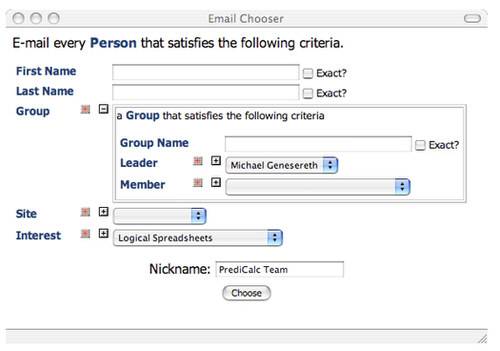A prototype email system being developed at Stanford University is designed to bring the power of semantic technology to our inbox. Called SEAmail, short for “semantic email addressing,” the system will help its users route email to the correct person or persons without needing to know their names or email addresses and without the need for preexisting distribution groups.

How SEAmail Works
According to MIT’s Technology Review, the program allows users to select email recipients by creating a search query as opposed to typing in names, addresses, or the name of a mailing list. For example, a user could use SEAmail to send a message to a group – created on the fly – like “all professors who graduated from Harvard University since 1960.”
Being able to pinpoint your recipients in this way would not only be helpful, it could also stem the overflow of email that creates information overload by making sure that only the exact recipients who need to get the message are contacted.
A Semantic Email Chooser
In SEAmail, a email addressing interface (as shown here) could be used to build a list on the fly, without necessarily needing to know a single name. Instead, all an email user would need to do is fill in the parts of the form using the drop-down boxes to guide their selections along the way. The system would then take care of the rest.

Pulling from Databases
Obviously, in order for a semantically-based email system to work, there needs to be a rich database on the back-end that contains relevant information about the people sending email to each other and their interests. In the Stanford tests, this data is being retrieved from already existing databases which are then integrated into the system.
While such a thing may work well at a university like Stanford, it may be less useful to real-world businesses where there aren’t numerous existing databases to draw upon, only Active Directory or some other resource management system.
Drawbacks and Concerns
1) Does this solve real problems?
There’s also the small question as to whether SEAmail is solving a problem that really needs to be solved. Take for instance one of the touted benefits of the system: name resolution. The article provided an example where people wanting to send a message to “Michael Genesereth” could simply type his name as a recipient, and his most recent email address would automatically be selected. Sounds excellent, right? Except for one minor problem – that technology has existed in most email systems, and certainly within Microsoft Exchange, for years on end.
To continue the comparison with Microsoft Exchange, the advancements SEAmail makes have more to do with putting the power of creating these queries into the hands of users, who often don’t get involved with the business of creating distribution lists, leaving it up to I.T. to do it for them. Exchange’s built in ability to create query-based distribution lists already make it dead simple for admins to create lists based on almost any requirement you can dream up: city, state, organization, company, department, title, floor, supervisor, etc. In order for SEAmail to be revolutionary, it would need to do more than make it easy to create relevant lists – it would need to so while using much more detailed data about the intended recipients than any system allows for today.
2) Or Does it Create More Problems (like spam)?
Although in theory, the system’s ability to pinpoint users could cut back on unintended email, there’s also the possibility that the system could lead to more email. Oren Etzioni, director of the Turing Center at the University of Washington, has some concerns about the potential for misuse of the system. “This technology has clear benefits, but it’s also ripe for misuse,” he says. “The technical issues are solvable. The tricky things are the social issues. How do we create a workable system, given the vagaries of human nature?” Etzioni worries that a system that makes it too easy would lead to some people receiving overwhelming amounts of mail and no good way to limit it.
3) What about Social Networking?
Technology analyst Craig Roth thinks that the most glaring issue here is that the system doesn’t take into account how social networks are being used by those who need to contact, market to, or inform others. He notes that consumers today can use LinkedIn, Facebook, MySpace, and Xing while enterprise customers have IBM Lotus Connections, MySites in Microsoft SharePoint, and the social search capabilities that were in BEA Pathways were merged into Oracle’s secure enterprise search.
Arriving Later this Year
Of course, it’s hard to get a real feel for the potential of a system like this until it’s actually put into practice. As it turns out, that will happen very soon. SEAmail will be launched at Stanford later this year, initially in the computer science department. It will later be rolled out to the rest of the university over time.





















